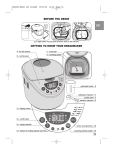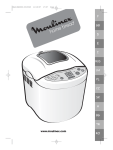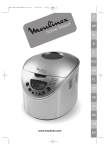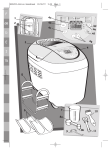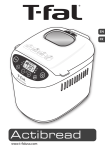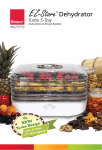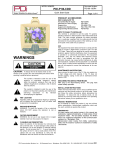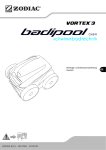Download Moulinex Bread Maker Troubleshooting guide
Transcript
VBM400 MOULI not Ref 3313347 19/06/06 11:56 Page 16 BEFORE YOU BEGIN GB 10 11 12 6 7 1 8 2 3 4 9 5 A slight odour may be given off when used for the first time GETTING TO KNOW YOUR BREADMAKER A - lid with window B - control panel C - bread pan 10 11 6 8 2 3 1 4 9 5 10 6 11 7 2 12 7 1 D - kneading paddle 3 8 12 E - graduated beaker f1 - tablespoon measure F - double doser f2 - teaspoon measure b1 - display screen b7 - Main indicator lamp b3 - weight selection b6 - choice of programmes b5 - browning selection button b4 - buttons for setting start delay and adjusting the time for programme 12 b2 - on/off button 15 VBM400 MOULI not Ref 3313347 19/06/06 11:56 Page 17 INTRODUCTION Bread plays an important role in our nutrition. Who has never dreamed of making their own freshly baked bread at home? Now you can using a breadmaker. Whether you are a beginner or an expert, all you have to do is add the ingredients and the breadmaker does the rest. You can easily make bread, bread dough, pizza dough, brioche, pasta and jam effortlessly. However be aware that to make the most of your breadmaker a certain learning curve is necessary. Take the time to get to know it and don’t be disappointed if your first attempts aren’t quite perfect. But if you’re impatient to make your first loaf, one of the recipes in the quick-start paragraph will help you take your first steps. Note that the texture of the bread you’ll get is more compact than bread from a bakery. Also, remember that all baked loaves have a hole underneath where the kneading paddles are positioned while the bread is baking in the pan. FIRST STEPS TIPS FOR MAKING GOOD BREAD 1. Read the instructions carefully and use the reci- 5. To avoid spoiling the proving of the dough, we pes: breadmaking using this appliance is not the same as breadmaking by hand! advise that all ingredients should be put in the bread pan at the start and that you should avoid opening the lid during use (unless otherwise indicated). Carefully follow the order of ingredients and quantities indicated in the recipes. First the liquids, then the solids. Yeast should not come into contact with liquids, sugar or salt. 2. All ingredients used must be at room temperature (unless otherwise indicated) and must be weighed exactly. Measure liquids with the graduated beaker supplied. Measure liquids with the graduated beaker supplied. Use the double doser supplied to measure teaspoons on one side and tablespoons on the other. All spoon measures are level and not heaped. Incorrect measurements give bad results. 3. For successful bread making using the correct ingredients is critical. Use ingredients before their use-by date and keep them in a cool, dry place. 4. It is important to measure the quantity of flour precisely. That is why you should weigh out flour using a kitchen scale. Use packets of active dry baker’s yeast. Unless otherwise indicated in the recipe, do not use baking powder. Once a packet of yeast has been opened, it should be used within 48 hours. 16 GENERAL ORDER TO BE FOLLOWED: Liquids (butter, oil, eggs, water, milk) Salt Sugar Flour, first half Powdered milk Specific solid ingredients Flour, second half Yeast VBM400 MOULI not Ref 3313347 19/06/06 11:56 Page 18 QUICK-START To get to know your breadmaker, we suggest trying the BASIC BREAD recipe for your first loaf. BASIC BREAD (programme 1) tsp > teaspoon tbsp > tablespoon BROWNING WEIGHT TIME OIL WATER > > > > > MEDIUM 1000 g 3 : 18 2 tbsp 330 ml SALT SUGAR POWDERED MILK WHITE BREAD FLOUR YEAST > > > > > 1,5 tbsp 1 dsp 2 dsp 605 g 1,5 tbsp Lift out the bread trough by lifting the handle and pulling forwards and backwards to unclip the two sides, one by one. Fit the kneading paddles. Put the ingredients in the pan in exactly the order recommended. Make sure that all ingredients are weighed with precision. Place the bread pan in the breadmaker. Replace the bread trough and press on one side then the other to engage the mixer drives and clip it in on both sides. Plug in the bread maker and switch it on. After the audible signal, the default indication of programme 1 (1P) will appear (1000 g, medium browning), followed by the corresponding time. Press the button. The timer colon flashes. The operating indicator lights up. Unplug the breadmaker at the end of the cooking or warming cycle. Lift the bread pan out of the breadmaker by pulling on the handle. Always use oven gloves as the pan handle is hot, as is the inside of the lid. Turn out the hot bread and place it on a rack for at least 1 hour to cool. 17 VBM400 MOULI not Ref 3313347 19/06/06 11:56 Page 19 USING YOUR BREADMAKER A default setting is displayed for each programme. You will therefore have to select the desired settings manually. SELECTING A PROGRAMME Choosing a programme triggers a series of steps which are carried out automatically one after another. The MENU button enables you to choose a certain number of different programmes. The time corresponding to the programme is displayed. Every time you press the , The number on the display panel switches to the next programme from 1-12: 1 2 3 4 > basic white bread > fast basic bread > French bread > wholemeal bread 5 6 7 8 > fast wholemeal bread > sweet bread > fast sweet bread > super-fast bread 9 > cake 10 > jams and compots 11 > leavened dough (pizza for example) 12 > cooking only 1. The Basic Bread programme is used to make most bread recipes using white wheat flour. 9. The cake programme can be used to make pastries and cakes with baking powder. 2. This programme is equivalent to the basic bread programme but is a faster version. The bread obtained may have a slightly denser crumb 10. The Jams programme automatically cooks jams and compots (stewed fruits) in the pan. 3. The French Bread programme corresponds to a traditional French crusty white bread recipe. 4. The Wholemeal Bread programme should be selected when using wholemeal bread flour. 5. This programme is equivalent to the wholemeal bread programme but is a faster version. The bread obtained may have a slightly denser crumb. 6. The sweet bread programme is appropriate for recipes containing more fat and sugar. 7. This programme is equivalent to the sweet bread programme but is a faster version. The bread obtained may have a slightly denser crumb. 8. The super-fast bread programme is specifically for the SUPER-FAST BREAD recipe (page 22). 18 11. The Leavened Dough programme does not bake. It is a kneading and rising programme for all leavened doughs such as pizza dough, rolls, sweet buns. 12.The cooking programme is limited to10 to 60 mn adjustable in steps of 10 min. It can be selected alone and used: a) with the Leavened Dough programme, to reheat cooked and cooled breads or to make them crusty while still in the trough, c) to finish cooking in case of a prolonged electricity cut during a bread baking cycle. The breadmaker should not be left unattended when using programme 12. To stop the programme or to cancel delayed programming, hold down on the button for 5 seconds. VBM400 MOULI not Ref 3313347 SELECTING 19/06/06 11:56 THE WEIGHT OF THE BREAD The bread weight is set by default at 1000 g. This weight is shown for informational purposes. See the recipes for more details. Programmes 10, 11, 12 do not have weight settings. Press the button to set the chosen product - 500 g, 750 g or 1000 g. The indicator light against the selected setting comes on. SELECTING THE COLOUR OF THE CRUST (BROWNING) Page 20 If you want to change the default setting, press the button until the indicator light facing the desired setting comes on. START/STOP Press the button to switch the appliance on. The countdown begins. You can stop or cancel the delayed programme by holding down button . The indicator light will go out. By default, the colour of the crust is set at MEDIUM. Programmes 10, 11, 12 do not have a colour setting. Three choices are possible: LIGHT (L) - MEDIUM (P) - DARK (H). CYCLES On pages 24-25 is a table showing the steps in the various cycles according to the chosen programme. PREHEATING Used for programmes 4 and 5 to let the dough rise better. > KNEADING For forming the dough’s structure so that it can rise better. > REST > RISING Allows the dough to rest to improve kneading quality. PREHEATING: only activated for programmes 4 and 5. The kneading paddle does not operate during this period. This step accelerates yeast activity and thus encourages rising in breads made of flours which tend not to rise well. KNEADING: the dough is in the 1st or 2nd kneading cycle or in a stirring period between rising cycles. During this cycle, and for programmes 1, 2, 4, 5, 6, 7, you can add ingredients: dried fruit or nuts, olives, bacon pieces, etc. A beep indicates when you can intervene. See the summary table for preparation times (page 2425) and the “extra” column. This column indicates the time that will be displayed on your appliance’s screen when the beep sounds. For more precise information on how long before the beep sounds, subtract the “extra” column time from the total baking time. > BAKING Time during which the yeast works to let the bread rise and to develop its aroma. Transforms the dough into bread and gives it a golden, crusty crust. > WARMING Keeps the bread warm after baking. It is recommende that the bread should be turned out promptly after baking, however. For example: “extra” = 2:51 and “total time” = 3:13, the ingredients can be added after 22 min. RISING: the dough is in the 1st, 2nd or 3rd rising cycle. BAKING: the bread is in the final baking cycle. WARMING: for programmes 1, 2, 3, 4, 5, 6, 7, et 8, you can leave your preparation in the appliance. A one-hour warming cycle automatically follows baking. The display remains at 0:00 for one hour of warming. The appliance beeps at regular intervals. At the end of the cycle, it stops automatically after several beeps. 19 VBM400 MOULI not Ref 3313347 19/06/06 11:56 Page 21 DELAYED START PROGRAMME You can programme the appliance up to start 13 hours in advance to have your preparation ready at the time you want. This function cannot be used on programmes 8, 9, 10, 11, 12. This step comes after selecting the programme, browning level and weight. The programme time is displayed. Calculate the time difference between the moment when you start the programme and the time at which you want your preparation to be ready. The machine automatically includes the duration of the programme cycles. Using the and buttons, display the calculated time ( up and down). Short presses change the time by intervals of 10 min + a short beep. Holding the button down gives P RACTICAL continuous scrolling of 10-min intervals. For example, it is 8 pm and you want your bread to be ready for 7 am the next morning. Programme 11:00 using the and buttons. Press the button - an audible signal will be given and colon of the timer display will blink. The countdown begins. The ON light switches on. If you make a mistake or want to change the time setting, hold down the button until it makes a beep. The default time is displayed. Start the operation again. With the delayed start programme do not use recipes which contain fresh milk, eggs, soured cream, yoghurt, cheese or fresh fruit as they could spoil or stale overnight. ADVICE If there is a power cut: if, during the cycle, the programme is interrupted by a power cut or mishandling, the machine has a 7-min protection time during which the settings are saved. The cycle starts again where it stopped. Beyond that time, the settings are lost. If you plan to run a second programme bake a second loaf, open the lid and wait 1 hour before beginning the second preparation to allow the appliance to cool down completely. LES INGREDIENTS FATS AND OILS: fats make the bread softer and tastier. It also stores better and longer. Too much fat slows down rising. If you use butter, cut it into tiny pieces so that it is distributed evenly throughout the preparation, or soften it. You can substitute 15g butter for 1 tablespoon of oil. Do not add hot butter. Keep the fat from coming into contact with the yeast, as fat can prevent yeast from rehydrating. Do not use low fat spreads or butter substitutes. EGGS: eggs make the dough richer, improve the colour of the bread and encourage the development of the soft, white part. If you use eggs, reduce the quantity of liquid you use proportionally. Break the egg and top up with the liquid until you reach the quantity of liquid indicated in the recipe. Recipes are designed for one 50 g size egg; if your eggs are bigger, add a little flour; if they are smaller, use less flour. 20 MILK: recipes use either fresh or powdered milk. If using powdered milk, add the quantity of water stated in the recipe. It enhances the flavour and improves the keeping qualities of the bread. For recipes using fresh milk, you can substitute some of it with water but the total volume must equal the quantity stated in the recipe. Semi-skimmed or skimmed milk is best to avoid bread having a close texture. Milk also has an emulsifying effect which evens out its airiness, giving the soft, white part a better aspect. WATER: water rehydrates and activates the yeast. It also hydrates the starch in the flour and helps the soft, white part to form. Water can be totally or partially replaced with milk or other liquids. Use liquids at room temperature. VBM400 MOULI not Ref 3313347 19/06/06 11:56 FLOUR: the weight of the flour varies significantly depending on the type of flour used. Depending on the quality of the flour, baking results may also vary. Keep flour in a hermetically sealed container, as flour reacts to fluctuations in atmospheric conditions, absorbing moisture or losing it. Use “strong flour”, “bread flour” or “baker’s flour” rather than standard flour. Adding oats, bran, wheat germ, rye or whole grains to the bread dough will give a smaller, heavier loaf of bread. Using T55 flour is recommended unless otherwise specified in the recipe. Sifting the flour also affects the results: the more the flour is whole (i.e. the more of the outer envelope of the wheat it contains), the less the dough will rise and the denser the bread. You can also find readyto-use bread preparations on the market. Follow the manufacturer’s instructions when using these preparations. Usually, the choice of the programme will depend on the preparation used. For example: Wholemeal bread - Programme 4. If you use ready-made mixes for making bread, brioches or milk loaves, do not exceed 1,000 g of dough in total. SUGAR: use white sugar, brown sugar or honey. Do not use unrefined sugar or lumps. Sugar acts as food for the yeast, gives the bread its good taste and improves browning of the crust. Artificial sweeteners cannot be substituted for sugar as the yeast will not react with them. SALT: salt gives taste to food and regulates the yeast’s activity. It should not come into contact with the yeast. Thanks to salt, the dough is firm, compact and does not rise too quickly. It also improves the structure of the dough. Use ordinary table salt. Do not use coarse salt or salt substitutes. P RACTICAL Page 22 YEAST: yeast is what makes the dough rise. Use active dry baker’s yeast in packets. The quality of yeast can vary, and it does not always rise in the same way. Bread can therefore come out differently depending on the yeast used. Old or poorly stored yeast will not work as well as a freshly opened packet of dry yeast. The proportions indicated are for flaked dried yeast. If you use fresh yeast, multiply the quantity by 3 (in weight) and dilute the yeast in a small amount of warm water with a little sugar for more effective action. There are dry yeasts in the form of small granular pellets that have to be rehydrated with a small amount of warm water with a little sugar. These are used in the same proportions as flaked dry yeast, but we recommend the latter as it is easier to use. ADDITIVES (OLIVES, BACON PIECES, ETC.): you can add a personal touch to your recipes by adding whatever ingredients you want, taking care: > to add following the beep for additional ingredients, especially those that are fragile such as dried fruit, > to add the most solid grains (such as linseed or sesame) at the start of the kneading process to facilitate use of the machine (delayed starting, for example), > to thoroughly drain moist ingredients (olives), > to lightly flour fatty ingredients for better blending, > not to add too large a quantity of additional ingredients, especially cheese, fresh fruit and fresh vegetables, as they can affect the development of the dough, > to finely chop nuts as they can cut through the loaf structure and reduce the cooked height. ADVICE Bread preparation is very sensitive to temperature and humidity conditions. In case of high heat, use liquids that are cooler than usual. Likewise, if it is cold, it may be necessary to warm up the water or milk (never exceeding 35°C). Any liquid used should be tepid, about 20 to 25°C (except for Super Fast Bread which should be 35 to 40°C max.). It can also sometimes be useful to check the state of the dough during the second kneading: it should form an even ball which comes away easily from the walls of the pan. > if not all of the flour has been blended into the dough, add a little more water, > if the dough is too wet and sticks to the sides, you may need to add a little flour. Such corrections should be undertaken very gradually (no more than 1 tablespoon at a time) and wait to see if there is an improvement before continuing. A common error is to think that adding more yeast will make the bread rise more. Too much yeast makes the structure of the bread more fragile and it will rise a lot and then fall while baking. You can determine the state of the dough just before baking by touching it lightly with your fingertips: the dough should be slightly resistant and the fingerprint should disappear little by little. 21 VBM400 MOULI not Ref 3313347 19/06/06 11:56 Page 23 RECIPES tsp > teaspoon - tbsp > tablespoon For each recipe, add the ingredients in the exact order indicated. Depending on the recipe chosen and the corresponding programme, you can take a look at the summary table of preparation times (pages 24-25) and follow the breakdown for the various cycles. PROGRAMMES 1-2 BASIC WHITE BREAD Sunflower oil Water Salt Sugar Powdered milk White bread flour Yeast PROGRAMME 3 Water Salt White bread flour Yeast MILK LOAF 500 g 750 g 1000 g 3,5 tsp 190 ml 1 tsp 2,5 tsp 1,5 tbsp 350 g 1 tsp 1,5 tbsp 250 ml 1 tsp 3 tsp 1,5 tbsp 455 g 1 tsp 2 tbsp 330 ml 1,5 tsp 1 tbsp 2 tbsp 605 g 1,5 tsp Butter, softened, diced Salt Sugar Liquid milk White bread flour Yeast FRENCH BREAD 750 g 1000 g 210 ml 1 tsp 360 g 0,5 tsp 275 ml 1,5 tsp 465 g 1 tsp 365 ml 2 tsp 620 g 1.5 tsp Water Salt White bread flourr Rye flour Yeast 1000 g 70 g 1,5 tsp 3 tbsp 350 ml 530 g 1,5 tsp 500 g 750 g 1000 g 210 ml 1 tsp 290 g 70 g 1 tsp 275 ml 1,5 tsp 370 g 90 g 1 tsp 365 ml 2 tsp 395 g 125 g 1,5 tsp PEASANT BREAD 500 g 750 g 1000 g 1,5 tsp 210 ml 1.5 tsp 1,5 tsp 140,5 g 210 g 0.5 tsp 2 tbsp 290 ml 1.5 tsp 2 tsp 200 g 300 g 1 tsp 2.5 tbsp 355 ml 2 tsp 2.5 tbsp 240 g 365 g 1,5 tsp 500 g 750 g 1000 g 2 115 g 45 ml 1 tsp 2,5 tbsp 280 g 1,5 tsp 2 150 g 60 ml 1 tsp 3 tbsp 365 g 2 tsp 3 195 g 80 ml 1,5 tsp 4 tbsp 485 g 3 tsp Sunflower oil Water Salt Powdered milk Sugar Flour White bread flour Wholemeal flour Yeast 500 g 750 g 1000 g 1,5 tsp 205 ml 1 tsp 1 tbsp 1,5 tsp 180 g 85 g 85 g 0.5 tsp 2 tsp 290 ml 1.5 tsp 1.5 tbsp 2 tsp 255 g 120 g 120 g 1 tsp 2.5 tsp 355 ml 2 tsp 2 tbsp 2.5 tbsp 310 g 145 g 145 g 1,5 tsp 500 g 750 g 1000 g 2 100 g 60 ml 1 tsp 3,5 tbsp 270 g 1,5 tsp 80 g 2 130 g 80 ml 1 tsp 4 tbsp 345 g 2 tsp 100 g 3 175 g 105 ml 1,5 tsp 6 tbsp 460 g 3 tsp 130 g KUGELHOPF PROGRAMMES 6-7 BRIOCHE Eggs Butter Liquid milk Salt Sugar Flour Yeast 750 g 50 g 1 tsp 2,5 tbsp 260 ml 400 g 1 tsp FARMHOUSE LOAF 500 g PROGRAMMES 4-5 WHOLEMEAL LOAF Sunflower oil Water Salt Sugar Flour Wholemeal flour Yeast 500 g 40 g 1 tsp 2 tbsp 200 ml 310 g 1 tsp Eggs Butter Liquid milk Salt Sugar Flour Yeast Raisins Optional: soak the raisins in a light syrup… Optional: place whole almonds on the top of the dough. PROGRAMME 8 SUPER FAST BREAD 1000 g Sunflower oil Water (35-45OC max.) Salt Sugar Powdered milk Flour Yeast 1,5 tbsp 360 ml 1,5 tsp 1 tbsp 2,5 tbsp 565 g 3,5 tsp PROGRAMME 9 Eggs Butter Salt Sugar Flour Baking powder Lemon (juice+zest) LEMON CAKE 3 70 g 1 pinch 195 g 320 g 2,5 tsp 1 ALMOND CAKE Eggs Butter Salt Sugar Dark rum Flour Powdered almonds Baking powder 3 105 g 1 pinch 135 g 3 tbsp 155 g 135 g 2 tsp Beat the eggs + sugar + salt until white PROGRAMME 10 JAMS AND COMPOTES Strawberry, peach, rhubarb Orange or apricot jam marmelade Fruits 580 g Fruits 500 g Sugar 360 g Sugar 400 g Pectin 30 g Pectin 50 g Lemon juice 1 Cut or chop up the fruit of your choice before putting in the breadmaker. 22 PROGRAMME 11 Apple/rhubarb compote Fruits 750 g Sugar 5càs PIZZA DOUGH 750 g Olive oil Water Salt Flour Yeast 1 tbsp 240 ml 1,5 tsp 480 g 1 tsp VBM400 MOULI not Ref 3313347 19/06/06 11:56 Page 24 TROUBLESHOOTING GUIDE Not getting the expected results? This table will help you. Bread rises too much Bread falls after rising too much Bread does not rise enough Crust not golden enough Sides brown Top but bread not and sides fully cooked floury The button was pressed during baking Not enough flour Too much flour Not enough yeast Too much yeast Not enough water Too much water Not enough sugar Poor quality flour Wrong proportions of ingredients (too much) Water too hot Water too cold Wrong programme TECHNICAL TROUBLESHOOTING GUIDE PROBLEMS SOLUTIONS The kneading paddle remain stuck in the bread trough • Let it soak before removing it. The kneading paddle remain stuck in the loaf • Lightly oil the kneading paddles before mixing the ingredients in the bread pan or use the accessory to turn out the loaf After pressing on • The machine is too hot. The following error message will be shown: EO1 and 5 beeps. Wait 1 hour between 2 cycles. • The programme includes preheating • A delayed start has been programmed. , nothing happens After pressing on , the motor is on but no kneading takes place • The pan has not been correctly inserted. • Kneading paddle missing or not installed properly. After a delayed start, the bread has not risen enough or nothing happens after programming. • You forgot to press on • The yeast has come into contact with salt and/or water. • Kneading paddle missing. Burnt smell • Some of the ingredients have fallen outside the pan: let the machine cool down and clean the inside of the machine with a damp sponge and without any cleaning product. • The preparation has overflowed: the quantity of ingredients used is too great, notably liquid. Follow the proportions given in the recipe. 23 VBM400 MOULI not Ref 3313347 PROG. BROWN- WEIGHT TOTAL ING 1 2 3 4 5 24 TIME (h) 1 500 750 1000 3:08 3:13 3:18 2 500 750 1000 3:08 3:13 3:18 3 500 750 1000 1 PRE 1st HEATING KNEADING 19/06/06 REST 11:56 2nd KNEADING 1st RISING Page 25 3rd KNEADING 2nd RISING 4th KNEADING 3rd RISING COOKING EXTRA KEEP HOT (h) 0:43 0:48 0:53 2:46 1:00 2:51 1:00 2:56 1:00 0:43 0:48 0:53 2:46 1:00 2:51 1:00 2:56 1:00 3:08 3:13 3:18 0:43 0:48 0:53 2:46 1:00 2:51 1:00 2:56 1:00 500 750 1000 2:07 2:12 2:17 0:43 0:48 0:53 1:45 1:00 1:50 1:00 1:55 1:00 2 500 750 1000 2:07 2:12 2:17 0:43 0:48 0:53 1:45 1:00 1:50 1:00 1:55 1:00 3 500 750 1000 2:07 2:12 2:17 0:43 0:48 0:53 1:45 1:00 1:50 1:00 1:55 1:00 1 500 750 1000 3:28 3:30 3:32 0:48 0:50 0:52 - 1:00 1:00 1:00 2 500 750 1000 3:28 3:30 3:32 0:48 0:50 0:52 - 1:00 1:00 1:00 3 500 750 1000 3:28 3:30 3:32 0:48 0:50 0:52 - 1:00 1:00 1:00 1 500 750 1000 3:41 3:43 3:45 0:46 0:48 0:50 2:54 1:00 2:56 1:00 2:58 1:00 2 500 750 1000 3:41 3:43 0:30:00 0:05:00 0:05:00 0:15:00 3:45 0:46 0:48 0:50 2:54 1:00 2:56 1:00 2:58 1:00 3 500 750 1000 3:41 3:43 3:45 0:46 0:48 0:50 2:54 1:00 2:56 1:00 2:58 1:00 1 500 750 1000 2:26 2:28 2:30 0:46 0:48 0:50 2:04 1:00 2:06 1:00 2:08 1:00 2 500 750 1000 2:26 2:28 0:05:00 0:05:00 0:05:00 0:15:00 2:30 0:46 0:48 0:50 2:04 1:00 2:06 1:00 2:08 1:00 3 500 750 1000 2:26 2:28 2:30 0:46 0:48 0:50 2:04 1:00 2:06 1:00 2:08 1:00 x x x 0:05:00 0:05:00 0:20:00 0:05:00 0:05:00 0:20:00 0:05:00 0:05:00 0:20:00 0:39:00 0:00:10 0:25:50 0:00:15 0:49:45 0:15:00 0:00:10 0:08:50 0:00:10 0:29:50 0:39:00 0:00:10 0:30:50 0:00:10 0:59:50 0:49:00 0:00:10 0:25:50 0:00:10 0:44:50 0:24:00 0:00:10 0:10:50 0:00:10 0:34:50 VBM400 MOULI not Ref 3313347 PROG. BROWN- WEIGHT ING 6 7 TOTAL TIME (h) 1 500 750 1000 3:12 3:17 3:22 2 500 750 1000 3:12 3:17 3:22 3 500 750 1000 1 19/06/06 PRE 1st HEATING KNEADING REST 11:56 2nd KNEADING 1st RISING Page 26 3rd KNEADING 2nd RISING 4th KNEADING 3rd RISING COOKING EXTRA KEEP HOT (h) 0:45 0:50 0:55 2:50 2:55 3:00 1:00 1:00 1:00 0:45 0:50 0:55 2:50 2:55 3:00 1:00 1:00 1:00 3:12 3:17 3:22 0:45 0:50 0:55 2:50 2:55 3:00 1:00 1:00 1:00 500 750 1000 2:32 2:37 2:42 0:45 0:50 0:55 2:10 2:15 2:20 1:00 1:00 1:00 2 500 750 1000 2:32 2:37 2:42 0:45 0:50 0:55 2:10 2:15 2:20 1:00 1:00 1:00 3 500 750 1000 2:32 2:37 2:42 0:45 0:50 0:55 2:10 2:15 2:20 1:00 1:00 1:00 1000 1:20 x 0:05:00 x 0:15:00 0:12:00 x x x x 0:48 - 1:00 8 x x 0:05:00 0:05:00 0:20:00 0:39:00 0:00:10 0:25:50 0:00:05 0:51:55 0:05:00 0:05:00 0:20:00 0:25:00 0:00:10 0:15:50 0:00:05 0:35:55 9 - 1000 1:20 x 0:05:00 x 0:10:00 0:15:00 x x x x 0:50 - - 10 - - 1:05 x x x 0:05:00 0:10:00 x x x x 0:50 - - 11 - - 1:30 x 0:05:00 0:05:00 0:20:00 1:00:00 x x x x x - - 12 - - 0 to 10 in steps of 10 min. 0 to 10 in steps of 10 min. - - x Note: for programmes 1 to 8 inclusive, total time does not include the keep hot time. 25 VBM400 MOULI not Ref 3313347 19/06/06 11:56 Page 27 CLEANING AND MAINTENANCE • Unplug the appliance and let it cool down. • Clean the body of the appliance and the inside of the pan with a damp sponge. Dry thoroughly. • Wash the pan and kneading paddles in hot water. If the kneading paddles remains stuck in the pan, let it soak for 5 to 10 min. • Remove the lid to clean it with hot water. • Do not wash any part in a dishwasher. • Do not use household cleaning products, scouring pads or alcohol. Use a soft, damp cloth. • Never immerse the body of the appliance or the lid. SAFETY RECOMMENDATIONS LET’S HELP TO PROTECT THE ENVIRONMENT! Your appliance contains many materials that can be reused or recycled. Take it to a collection point so it can be processed. • This appliance complies with the technical safety rules and standards in force. • Carefully read the instructions before using your appliance for the first time: the manufacturer does not accept responsibility for use that does not comply with the instructions. • Young children and severely disabled persons who are not familiar with these instructions should only use this appliance under surveillance of a responsible adult. • Make sure that the power it uses corresponds to your electrical supply system. Any error in connection will cancel the guarantee. • You appliance must be plugged into an earthed socket. If this is not the case, an electric shock may be received, possibly causing serious lesions. For your safety, earthing must correspond to the electrical system standards applicable in your country. • Your appliance is designed for indoor home use only. • Unplug the appliance when you have finished using it and when you clean it. • Do not use the appliance if it is not working properly or if it has been damaged. If this occurs, contact an authorised service centre (see the list in the service booklet). • All interventions other than cleaning and everyday maintenance by the customer must be performed by an authorised service centre. • Do not immerse the appliance, power cord or plug in water or any other liquid. • Do not leave the power cord hanging within reach of children. • The power cord must never be close to or in contact with the hot parts of your appliance, near a source of heat or over a sharp corner. • Do not use the appliance if the power cord or plug is damaged. The power cord must be replaced by an authorised service centre to avoid any danger (see the list in the service booklet). 26 Do not touch the viewing window during and just after operation. The window can reach a high temperature. • Do not pull on the supply cord to unplug the appliance. • Do not place the appliance on other appliances. • Do not use the appliance as a source of heating. • Do not place paper, card or plastic in the appliance and place nothing on it. • Should any part of the appliance catch fire, do not attempt to extinguish it with water. Unplug the appliance. Smother flames with a damp cloth. • For your safety, only use accessories and spare parts designed for your appliance. • All appliances undergo strict quality control. Practical usage tests are performed on randomly selected appliances, which would explain any slight traces of use. • At the end of the programme, always use oven gloves to handle the pan or hot parts of the appliance. The appliance gets very hot during use. • Never obstruct the air vents. • Be very careful, steam can be released when you open the lid at the end of or during the programme. • When using programme No. 10 (jam, compotes) watch out for steam and hot spattering when opening the lid. • Caution, if the dough overflows the baking cavity and touches the heating element, it can catch fire, therefore: - do not exceed the quantities indicated in the recipes. - do not exceed a total of 1000 g of dough. • The measured noise level of this product is 72 dBA. •













